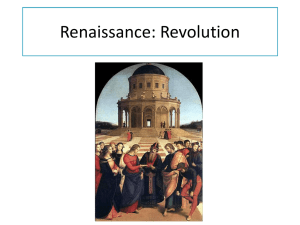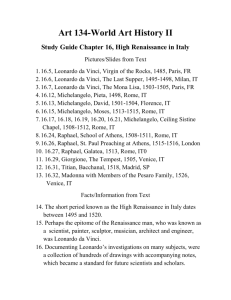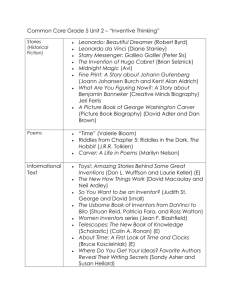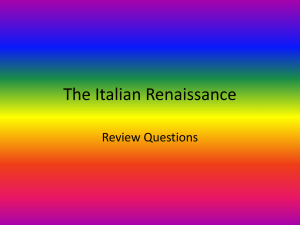High Renaissance (1495-1527)
advertisement
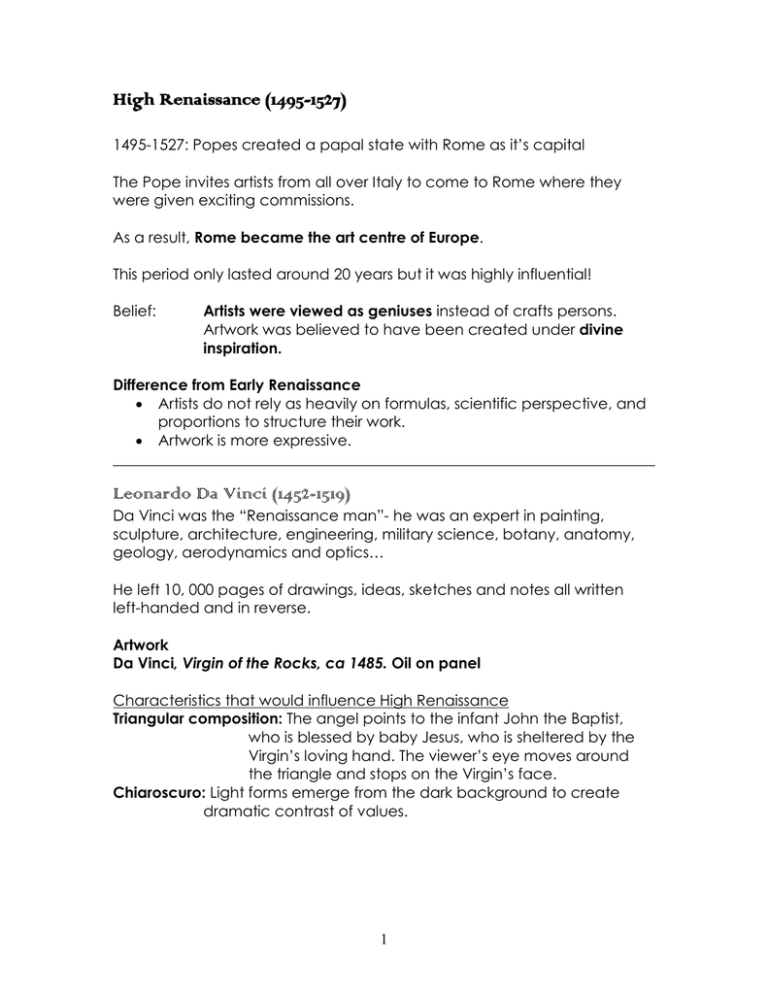
High Renaissance (1495-1527) 1495-1527: Popes created a papal state with Rome as it’s capital The Pope invites artists from all over Italy to come to Rome where they were given exciting commissions. As a result, Rome became the art centre of Europe. This period only lasted around 20 years but it was highly influential! Belief: Artists were viewed as geniuses instead of crafts persons. Artwork was believed to have been created under divine inspiration. Difference from Early Renaissance Artists do not rely as heavily on formulas, scientific perspective, and proportions to structure their work. Artwork is more expressive. ________________________________________________________________________ Leonardo Da Vinci (1452-1519) Da Vinci was the “Renaissance man”- he was an expert in painting, sculpture, architecture, engineering, military science, botany, anatomy, geology, aerodynamics and optics… He left 10, 000 pages of drawings, ideas, sketches and notes all written left-handed and in reverse. Artwork Da Vinci, Virgin of the Rocks, ca 1485. Oil on panel Characteristics that would influence High Renaissance Triangular composition: The angel points to the infant John the Baptist, who is blessed by baby Jesus, who is sheltered by the Virgin’s loving hand. The viewer’s eye moves around the triangle and stops on the Virgin’s face. Chiaroscuro: Light forms emerge from the dark background to create dramatic contrast of values. 1 Artwork Da Vinci, Mona Lisa, 1503-1506 World’s most famous portrait Characteristics that would influence High Renaissance She sits in a relaxed pose in front of a landscape. Sfumato: an effect where edges of objects are slightly blurred to create a hazy feeling and a feeling of enormous depth. Who is Mona Lisa? Multiple theories: 1. Signora Lisa Giaconda, wife of a wealthy Florentine (Based on the mid-sixteenth century biography of Leonardo da Vinci by Giorgio Vasari, who was a contemporary) BUT… if it had been commissioned, why did he not deliver it to the family and instead carry it around with him until his death and then give it to his friend? The panel is unsigned, undated and has no clues as to her identity (most portraits of the time included an indication of the family name or social status). 2. Mona Lisa is not a portrait of one woman, but an artful composite of many, Leonardo’s idealization of all womanhood. 3. May have been on of Da Vinci’s young male models in drag. 4. The Mona Lisa is not a portrait at all, but a “finzione”, an invention of Leonardo’s extraordinary imagination. Artwork Da Vinci. Last Supper, 1495-1498 Da Vinci experimented with oil mixed with tempera (the result of its deterioration. Over the years people have tried to restore it, but have caused more damage through over painting) “Last Suppers” were common Renaissance paintings usually located in the monastery dinning halls So why is da Vinci’s Last Supper different? 1. The scene represents the moment when Jesus has just announced the he will be betrayed, instead of depicting the moment of the bread and wine as body and blood of Christ. 2. He chose this moment so that he could explore the theme of isolation, which he may have felt, as well as betrayal. For the first time ever, Jesus is completely isolated. (Usually John has his head on Christ’s shoulder or lap) 3. Linear Perspective makes Jesus the Centre of Interest 4. All apostles are in groups of 3 to create compositional balance 2 Michelangelo BuonaRroti (1452- 1519) Michelangelo was considered the “greatest man ever known to the arts” Michelangelo was born of a poor family. At the age of 13, Michelangelo started to study art with the artist, Ghirlandaio, from whom he learned to paint frescos. Michelangelo was accepted into Lorenzo de Medici’s school for sculptors and was treated as a son in the Medici household. At the Medici school, he studied with Bertoldo, who was a student of Donatello. He developed an interest in Greek and Roman culture. Artwork (page 278) Michelangelo, Pietà, 1499-1500. Marble (1.74 meters tall) Very important Christian sculpture created and located in Rome. Mary holds the almost nude body of Christ on her lap She is not crying, but accepting of her son’s death as necessary for humanity’s salvation. Her ideal beauty reflects her purity Characteristics Folds of drapery Feeling of flesh The seated Madonna is overly large when compared to Jesus’ body. This is because Michelangelo wanted to create the pyramid composition with exact proportions. He signed his name across the band on Mary’s chest. Carved from a single block of marble. Polished in the style of the Early Renaissance. (Later works, parts are left roughly chiseled to contrast with the polish.) Artwork (page 279) Michelangelo, David, 1501-1504. Marble (4.09 meters tall) David is huge in size A symbol of human perfection God-like (Hercules and Apollo) and superhuman in his muscular perfection He stands in a contrapposto pose. His hands are the most expressive part of David’s body. 3 Comparison between Michelangelo’s and Donatello’s David Michelangelo Manly body Angry and defiant expression His sling rests over his left shoulder with a round stone held in his oversized right hand about to slay Goliath Donatello Young body David has already killed Goliath and has his foot on Goliath’s head Artwork Michelangelo, Sistine Chapel, 1508-1512 Fresco Commissioned by Pope Julius II in 1508 The fresco took 4 years to complete Depicts tales from the Old Testament, foretelling the coming of Jesus Michelangelo did over 200 preliminary sketches in preparation and painted over 400 figures He painted standing with much discomfort and disallowed anyone from entering the Chapel as he worked Artwork (page 280) Michelangelo, St. Peter’s Dome, 1546-1564 At 71 years of age Michelangelo was commissioned to finish the construction of St. Peter’s Dome Its original architect, Bramante, had died before the project finished Michelangelo modified it by adding a pointed, double shelled dome (like Brunelleschi’s); it is the largest dome in the world. Michelangelo died before St. Peter’s dome was complete The Church was planned in the shape of a Greek cross (equal arms) 4 Raphael Sanzio (1483-1520) Raphael’s Characteristics Balance and harmony Sculptural quality of Michelangelo Grace and feeling of Leonardo Detail and light of Perugino (Raphael’s first teacher) Raphael went to Rome in 1508 at the invitation of the Pop. Court painter until his early death at 37. Artwork (page 282) Raphael. School of Athens, 1509-1511 His masterpiece One of four large frescoes in the Stanza della Segnatura (Room of Signatures) Perfectly Renaissance: balances Pagan Classicism and Renaissance Christianity. Depicted heroes from both Classical and Christian time Poses based on Classical Figures (also influenced by Sistine Chapel ceiling) Included poets, artists, and lawmakers. o Aristotle and Plato (modeled on Leonardo) are in deep conversation in the centre of the doorway. Leonardo influenced his handling of balance and composition (like Last Supper) o Michelangelo is sitting and thinking (hugely influential for Raphael). Can be seen in the sculptural quality, individual poses and the manner in which he grouped his figures) o Raphael includes himself on the right side looking directly at the viewer. Architectural setting is the interior of the incomplete St. Peter’s 5 Titian (Tiziano Vecellio) (1490-1576) Artistic giant of Venice, comparable to Michelangelo in Rome. Believed that colour and mood were more important in painting than line and scientific accuracy. Artwork (page 287) Titian, Venus with the Mirror, 1555. Innovative Painting technique Painted his figures in bright colour over a red-painted background, which added warmth to the entire work After it was dry, the surface was painted with as many as 30-40 glazes. o Glazes: transparent mixtures of colour and medium. Brushstrokes were visible which is called painterly No hard edges or outlines Three subjects: Pagan mythology, esp. involving Venus Portraits of important people and rulers Emotional religious subjects 6

